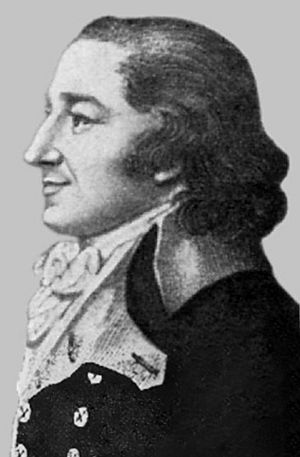Jeremias Benjamin Richter facts for kids
Quick facts for kids
Jeremias Benjamin Richter
|
|
|---|---|
 |
|
| Born | 10 March 1762 |
| Died | 4 May 1807 (aged 45) |
| Nationality | German |
| Known for | Law of reciprocal proportions Stoichiometry |
Jeremias Benjamin Richter (born March 10, 1762 – died May 4, 1807) was an important German chemist. He was born in Hirschberg, which is now part of Poland. Richter worked as a mining official and later became a chemist for a royal porcelain factory in Berlin, Germany. He is famous for creating the word stoichiometry, which is a key idea in chemistry.
Contents
Discovering Chemical Measurements
Richter was one of the first scientists to carefully measure how much of different chemicals react with each other. He studied how much of an acid was needed to mix perfectly with a base. Acids and bases are two types of chemicals that can cancel each other out.
He noticed that specific amounts of different bases would always react with the same amount of a certain acid. This idea is very important in a process called Titration. Titration is a way chemists measure the exact amount of a substance in a solution.
Richter believed that chemistry was like a branch of applied mathematics. He tried to find mathematical rules for how chemicals combine. He thought the amounts of bases needed to react with an acid followed a pattern, and the amounts of acids followed another pattern.
The Law of Definite Proportions
One of Richter's biggest discoveries was the law of definite proportions. He proposed this law in 1792. This law states that in any pure chemical compound, the elements are always present in the same fixed ratio by weight.
For example, Richter found that it always took 615 parts of magnesia (MgO) to react with 1000 parts of sulfuric acid. No matter how much you started with, the ratio of these two chemicals in the reaction was always the same.
Another chemist, Ernst Gottfried Fischer, used Richter's data in 1802. Fischer created the first table of "chemical equivalents." This table showed how different chemicals compared to each other in reactions. He used sulfuric acid as a standard, giving it the value of 1000.
Richter's work helped set the stage for later discoveries about atoms. The law of definite proportions strongly suggested that chemical compounds are formed when atoms combine in very specific and constant ways.
What is Stoichiometry?
Between 1792 and 1794, Richter published a three-volume book about his work. In this book, he introduced the term stoichiometry. He defined it as "the art of chemical measurements, which has to deal with the laws according to which substances unite to form chemical compounds."
Simply put, stoichiometry is the part of chemistry that helps us understand and calculate the amounts of chemicals involved in reactions. It's like the recipe for chemical reactions, telling you exactly how much of each ingredient you need.
Richter was very interested in how mathematics could be used in chemistry. However, his writing style was sometimes hard to understand. Because of this, his important work wasn't widely known until Ernst Gottfried Fischer summarized it in easy-to-read tables in 1802.
See also
 In Spanish: Jeremias Benjamin Richter para niños
In Spanish: Jeremias Benjamin Richter para niños

